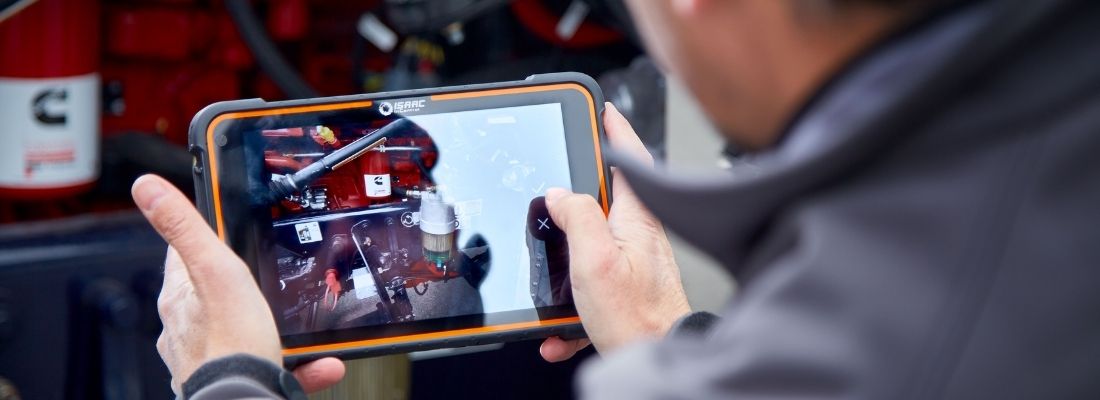Doing all these tasks manually wastes a significant amount of time and leaves room for error. Telematics with smart compliance features can make these tasks much easier. Find out how automation and notifications make follow-up efficient and simplify the work of compliance managers on many levels.
What Is Smart Compliance?
First, what do we mean by smart compliance? Simply defined, it’s the technology that notifies you of potential compliance issues in a proactive and timely manner, rather than having to audit to discover problems manually.
Smart compliance automation and notifications give managers peace of mind. They can rely on telematics to alert them in real time if there is a compliance issue. This allows both office staff and drivers to focus on higher value tasks. As mentioned, it also allows carriers to be proactive and ensure better compliance management.
HOS Compliance
Advanced telematics provide an integrated workflow for each driver. Workflows can be customized by carriers and assist drivers in their various activities, saving them time and effort, and making them more efficient.
For example, the electronic logbook is automatically updated to reflect the activities the driver performs. This ensures that each activity is associated with the proper HOS duty status while reducing the need for multiple inputs from the driver.
It is also possible to configure notifications to avoid hours of service violations. Alerts warn both the driver and the manager that there is a certain amount of time left before reaching a limit. Warnings appear on the driver’s ELD in a non-distracting way and allow drivers to better plan their stops and observe their hours of service. Office staff also receive these notifications. They are handy for guiding and supporting drivers to find a safe place to park.
Violation warnings also appear in real time. For example, if a driver reaches their driving time limit, the compliance manager will receive a notification to take action without delay.
Smart compliance prevents compliance managers from wasting time checking driver logs for violations. Technology performs these clerical tasks for greater efficiency.
Smart Driver Inspections
The smart DVIR includes all NSC 13 Schedule 1 items directly in the driver’s ELD. This ensures that all required inspection points are covered. Drivers avoid having to find the paper list that always gets lost in the permit book! The smart DVIR saves the driver time and effort, alleviates the need to memorize details, and provides an ongoing reminder.
But it doesn’t stop there. As soon as there is a defect, the driver can take a picture and add comments with their ELD. The second the DVIR is completed, the manager receives a notification. Real-time delivery of information to the right people improves compliance.
Smart driver notifications are also displayed on the in-cab ELD without being distracting. These include, for example, traveling with an expired DVIR, traveling with a violation in effect due to a major or a minor defect, or previously reported defects on a trailer about to be hooked up.
For the compliance manager, smart notifications may include a truck traveling with an expired DVIR or a truck traveling with a violation in effect due to a major or minor defect.
Wheel Retorquing
We covered the topic of wheel retorquing in a previous Western Canada Highway News article.
With tractor and trailer wheel changes recorded electronically instead of on paper, telematic systems can track distance traveled and issue retorquing reminders to the driver on their in-cab device when the wheel reaches the 80 km to 160 km mileage.
This is also possible for trailer wheels that may not be equipped with odometers; telematic systems can calculate the trailer’s piggy-back distance based on the distance the tractor has traveled.
Telematics also give managers a complete view of these critically important safety-related activities across the fleet. They can see wheel-retorquing activities and receive notifications for those that remain pending and create a safety risk.
IFTA Compliance
Manually calculating fuel tax is a tedious task. The risk of error is also higher than with the use of technology. Fortunately, telematics offers telemetry reports using precise geofencing that accurately details mileage by province and state. This automation reduces the administrative burden and ensures compliant and straightforward management.
Being Proactive and Efficient
In short, smart compliance gives compliance managers the tools to be proactive, act quickly, and be aware of what’s going on in their fleet, allowing them to focus their efforts where it is most profitable for the carrier. They are alerted when a situation requires attention. Rather than searching for the information, the information comes to them. A winning compliance management strategy also improves your safety score.

